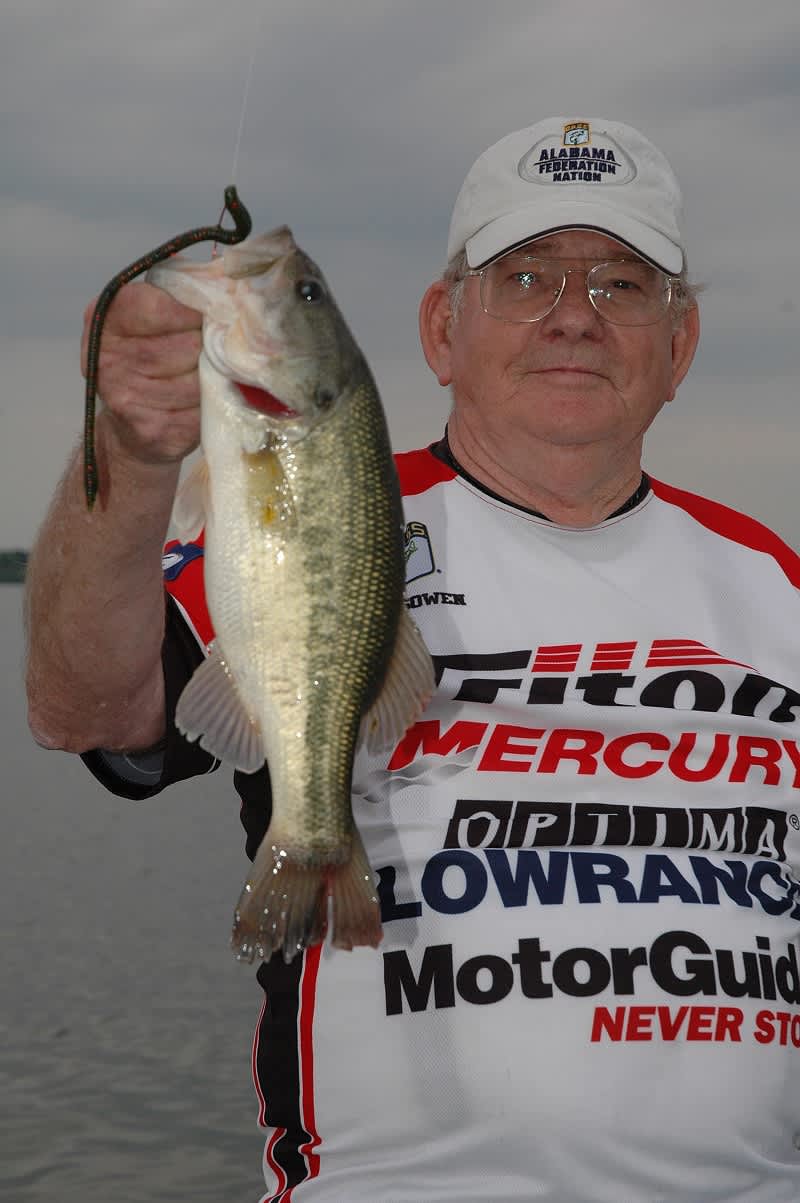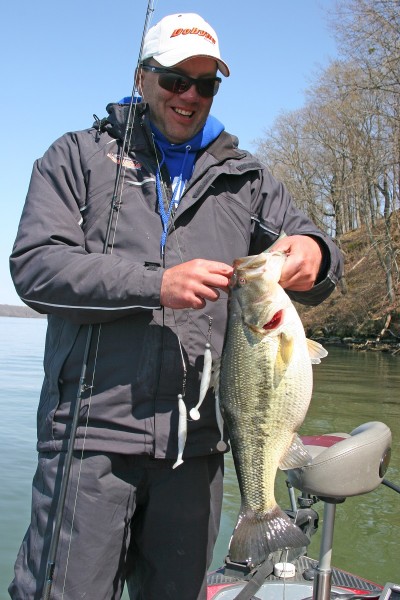Bass Fishing Thrives in Alabama According to Annual B.A.I.T. Report
David Rainer 07.03.14

Bass fishing in Alabama in 2013 was outstanding. But don’t take my word for it; that assessment came from those who are on the state’s abundant lakes and rivers almost every weekend through the Bass Anglers Information Team (B.A.I.T.) Report, published annually by the Alabama Wildlife and Freshwater Fisheries Division (WFF).
Damon Abernethy, WFF’s Fisheries Development Coordinator, said one particular Tennessee River lake maintained the momentum it established in 2012.
“If I were to say one thing that stands out, and it’s not necessarily a surprise—it was a surprise last year—is the resurgence of Wheeler Lake,” Abernethy said of the 2013 B.A.I.T. Report. “Although Wheeler has never been a poor fishery, there was a time in the late ’80s and early ’90s when it rivaled Lake Guntersville.”
Abernethy said the late ’90s is when the largemouth bass virus (LMBV) affected fisheries in 15 states, mostly across the South. The virus caused largemouth die-offs in numerous reservoirs, including several in Alabama. The virus has subsided and has not been implicated in any major problems since the mid-2000s.
“Since the bass virus hit in 1997, Wheeler never really appeared to recover from that,” Abernethy said. “There would be years when it improved, and then it would slack off again. During that same time, the grass disappeared. We do have biological evidence the bass virus, along with the loss of the grass, impacted the fishery. It was kind of a double whammy.
“But last year, Wheeler just shot through the roof, which was really surprising. I didn’t really expect that to continue this year, but it did. And it was even better.”
Abernethy said the Fisheries Section was so concerned about Wheeler that researchers at Auburn University were funded to perform a focused research project to help understand what impacted that fishery and how to make improvements.
“As soon as we signed the agreement, Wheeler just took off,” he said. “Since then, there’s been some amazing fishing up there. We’re very excited to see it continued, and 2012 and 2013 have been the best years Wheeler has had in a very long time.”
The B.A.I.T. Report relies on the bass clubs throughout the state to report the results of their tournaments. The report focuses on the 20 lakes that had at least five tournament reports in 2013. The lakes are ranked according to five indicators: percent success, average bass weight, bass per angler per day, pounds per angler per day, and hours per bass five pounds or larger.
According to Abernethy’s summary, during 2013, three of the four quality indicators were similar to the previous year’s (average bass weight was down five percent; percent success was up two percent; bass per angler per day was down one percent; and pounds per angler per day was down two percent). The statistic that really jumped out was the length of time required to catch a bass five pounds or larger. In 2013, it was 189 hours, which was a 20 percent improvement. This value was exceeded in only 1990 and 2010, with a 28-year average of 304 hours.
While Wheeler came out on top overall, many anglers consider Lake Guntersville as the top bass fishery in the nation. Abernethy said there are several factors that can skew the results a bit.
“I don’t think Wheeler has surpassed Guntersville,” he said. “Our tables can be a little bit deceiving unless you pay close attention. Guntersville has a 15-inch minimum length limit, which affects a lot of things. It’s going to depress your percent success and number of fish caught because they’re having to throw back the smaller fish. And it’s going to artificially inflate your average size.
“I think everybody will agree that Guntersville is the best bass lake in the state, but it never performs well in the overall quality indicators simply because of the length limit. For the hours it takes to catch a bass over five pounds, it’s still at the top and it usually is. Guntersville is still a phenomenal fishery.”

Millers Ferry on the Alabama River came in second in the overall category, followed by Wilson Reservoir, another Tennessee River impoundment.
“Wilson has really been coming on strong since we took the length limit off,” Abernethy said. “We were seeing some stockpiling of fish below the length limit. We pulled the length limit off several years ago, and it has really improved since then. This past year for Wilson was among the best years since we’ve been keeping these records.”
Abernethy said a contributing factor in Wilson’s move up the standings could be the increase in the reports received from the lake. He praised the cooperation of the Alabama B.A.S.S. Nation and its president, Eddie Plemons, for increasing the participation.
“They have really made an effort to encourage their clubs to participate in the report,” Abernethy said. “As a result, we’ve been getting a lot better information than we have in years past. We really appreciate them doing that. We’ve received reports from areas and lakes that have been weak in the past in the number of reports. Their efforts have really helped us improve our information in those areas. Eddie Plemons is responsible for what they’ve done for us.
“One thing about the B.A.I.T. Report is it’s important to know how many tournaments were used to make the report. Some lakes had 50 to 60 tournaments and others have five or six. One area that I do have to point out is the Mobile Delta. Those folks have really made an effort to improve their reporting. In 2013, we had 81 reports from the Mobile Delta, which is phenomenal.”
One lake that has slipped in the standings is Lake Jordan, which ended up in 11th place.
“Jordan has historically been near the top in all the categories,” Abernethy said. “For several years now, it’s been in the middle of pack, which is unusual for Jordan. There’s nothing wrong. It’s just been in a down cycle for two or three years. In 2014, it seems to be showing signs of rebounding.”
Abernethy said Pickwick had been really good for several years, but it has shown a little decline in the past couple of years.
“Part of that was due to big year-classes when the grass really exploded up there,” he said. “Those fish are getting older and dying out. It’s just a natural progression. The smallmouth fishery on Pickwick is as good as it’s ever been. We reduced the bag limit so that no more than five bass can be smallmouth. And there’s a minimum length of 15 inches for smallmouth on the whole Tennessee River system. That’s reduced mortality because the smaller fish have to be released immediately now.”
What’s known as the “Super Bowl of Bass Fishing,” the Bassmaster Classic, was held on Lake Guntersville in February. Randy Howell of Springville, Alabama, surged on the final day of fishing to take the crown with a three-day total of 67 pounds, eight ounces. Some had predicted the Classic record of 69-11, held by Kevin VanDam, would fall, but Mother Nature had other ideas, dumping more than three inches of rain on the lake just before the Classic started.
“I think people were expecting a better Classic, but I think people understand it was specific weather conditions that impacted the catch,” Abernethy said. “It was very muddy, and they weren’t able to bring in the big sacks like people expected. After the weather stabilized, they were cranking out 30-pound bags left and right.
“And in the B.A.I.T. Report, the number of bass five pounds or larger was up considerably. We had 553 bass over five pounds and 22 over eight pounds. There’s no shortage of big bass.”
Abernethy said the overall picture of the state in terms of bass fishing continues to impress not only anglers from Alabama but nationwide.
“The last seven or eight years have been really good, some of the best fishing statewide in 30 years,” he said. “We’ve seen some slight declines in places the last couple of years, but the overall quality of fishing in the state is better than it’s ever been.”
Click here to see the entire B.A.I.T. Report.

